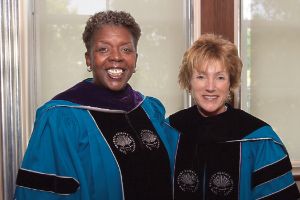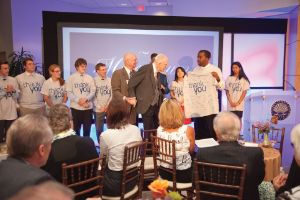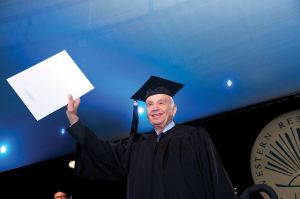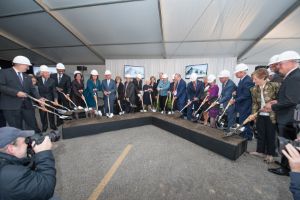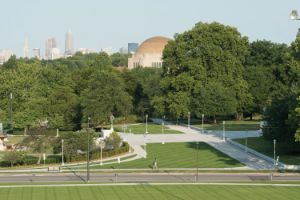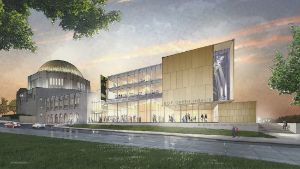features
Bridge Builder
By restoring trust and renewing relationships, Barbara R. Snyder transformed a troubled campus into an institution on the rise
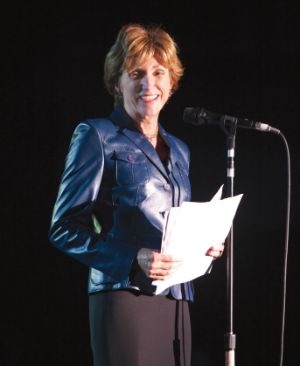 PHOTO: Anthony Gray
PHOTO: Anthony GrayBarbara R. Snyder introducing the Goo Goo Dolls for a concert during the 2011 BlueBash celebration, which launched the university's $1 billion Forward Thinking campaign.
On the eve of her last day as Case Western Reserve University's president, Barbara R. Snyder stood on a stage about to be seen by 73 million people.
The occasion was the first U.S. presidential debate, the location the Health Education Campus (HEC)—a joint project of the university and Cleveland Clinic.
It was a few minutes before the event's 9p.m. start, the period when C-SPAN broadcasts host leaders' remarks. Snyder explained that the HEC was a shared, state-of-the-art space where health professions students learned together before they teamed up to care for actual patients.
In bringing the building from idea to reality, she said, the two organizations had absorbed some lessons of their own. First among them?
"Through collaboration, we each can achieve more for society than either could alone."
***
"Clinic explores linking medical school with Columbia U., not Case"
The headline spanned the top of The Plain Dealer newspaper Sept. 5, 2007. Snyder had been president little more than nine weeks, and now one of the nation's leading hospitals was courting another campus.
 PHOTO: AP Images/Julio Cortez
PHOTO: AP Images/Julio CortezBarbara R. Snyder welcomed the audience to the first 2020 U.S presidential debate with Tom Mihaljevic, MD, Cleveland Clinic's chief executive officer and president. The university and Clinic co-hosted the event.
Relations between the university and Cleveland Clinic had cooled considerably in her predecessor's final months. Snyder had met with then-CEO Toby Cosgrove, MD, after being named president, but he had made no mention of a potential move for the medical program the hospital had established as part of Case Western Reserve University in 2002.
Her advisers urged condemnation. She needed to show strength—especially, one said, as the university's first female president.
Snyder listened, asked questions and then paused: "I am not going to burn a bridge," she told them, "I might someday want to walk back over."
That afternoon, she sent a letter to university supporters, noting: "…we value all of our partnerships with the Cleveland Clinic, and want to see every one of them thrive."
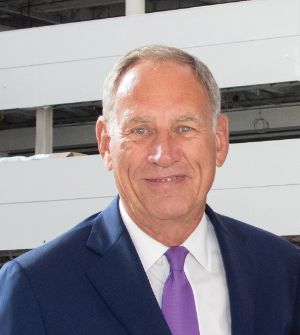 Toby Cosgrove
Toby Cosgrove
—Toby Cosgrove, MD, former Cleveland Clinic leader who teamed with Snyder to create the HEC
Although few knew it then, the day would exemplify Snyder's approach to leading Case Western Reserve University for the next 13 years. Always consultative and strategic, she seldom wavered from key principles: focus on people first; take the high road; and the one she articulated most often, under promise and overdeliver.
Coupled with exceptional energy and interpersonal skills,those principles allowed Snyder to transform a once-troubled campus into one recognized for extraordinary progress across multiple areas.
 PHOTO: Daniel Milner Photography
PHOTO: Daniel Milner PhotographyDuring a September celebration honoring Barbara R. Snyder, university trustee Frank Linsalata, (CIT '63), presented to Snyder a commemorative book of photos that highlights milestones from her tenure as president.
"She never ceases to amaze you," said Frank Linsalata (CIT '63), who led the search committee that hired Snyder and served as Board of Trustees chair at the time. "There are things you say she really can't get done, and she gets them done."
Barbara Rook Snyder came to Case Western Reserve after 19 years at The Ohio State University, the last four as a provost quickly known nationally for her high energy and effectiveness.
She would need both at Case Western Reserve University, where she faced a nearly $20 million deficit, disaffected alumni and a dispirited campus.
She spent the months before her start date visiting Cleveland regularly. In some instances, she introduced herself to key stakeholders; in others, she had to persuade donors planning to pull their pledges to give her a chance. In her first year, she met with alumni chapters in 26 cities and spoke to nearly every local group that invited her.
By June 30, 2008, giving topped $100 million— more than 50% higher than in 2006-2007. And the deficit? Gone, two years ahead of schedule.
That year, she created a new cabinet position, Vice President for Inclusion, Diversity and Equal Opportunity. At the time, it was among the first to report directly to the president, a model other campuses increasingly emulated. The announcement came soon after Snyder approved the launch of a Social Justice Institute, followed by tuition benefits for domestic partners, paid parental leave for funded graduate students—and, later, child-care support initiatives.
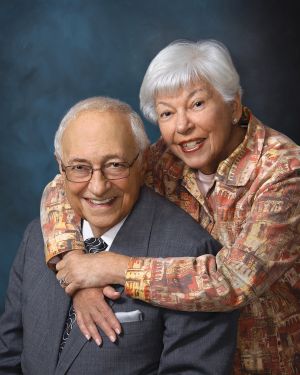 Milton and Tamar Maltz
Milton and Tamar Maltz
—Milton Maltz, president of the Milton and Tamar Maltz Family Foundation
As welcome as such tangible initiatives were, Snyder appreciated that personal gestures were at least as important. She regularly sent congratulatory letters to faculty, and each spring surprised teaching and mentoring award winners with visits to their classes. She joined students in the stands at football games, attended their plays and dance performances, and cheered them each April at the Hudson Relays. Undergraduates quickly dubbed her "Babs," and, before long, getting a photo with the president—and posting it on social media—became part of students' pre-graduation bucket list.
Adam Rupe (CWR '08), who led Undergraduate Student Government (USG) in Snyder's first year, recalled her giving him her cell phone number at one of their first meetings.
"That put me at ease," he recalled. "She wanted to have a true partnership with students."
***
By 2011, Snyder was ready to go public with the university's first capital campaign in 17 years, Forward Thinking. Alumni and other supporters already had pledged about two-thirds of its $1 billion goal, among them Tinkham Veale II (CIT '37), whose $20 million commitment a year earlier meant that work on a student center that had been discussed for decades would actually begin.
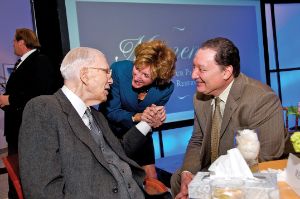 PHOTO: Daniel Milner Photography
PHOTO: Daniel Milner PhotographyTinkham Veale II (CIT '37), left, with Barbara R. Snyder and Cleveland Foundation President and CEO Ronn Richard at a May 2010 event announcing his $20 million commitment for what's now the Tinkham Veale University Center.
That same year, broadcast pioneer Milton Maltz and his wife, Tamar, pledged $12 million (which the family later increased to $30 million) to transform the historic Temple-Tifereth Israel into a performing arts center for students. In addition to providing a 1,200-seat venue for lectures and musical performances, the project also would offer space for student theater productions now relegated to a tiny basement stage in a former YMCA.
A few months before the campaign announcement, alumnus Joseph "J.B." Richey II (CIT '62) and his longtime business collaborator, A. Malachi Mixon III, pledged $5 million to support an innovation center for students. An idea driven in large measure by the energy and generosity of alumnus Larry Sears (CIT '69), think[box] would provide students advanced equipment and technology they could use for class projects—or startup companies.
While fundraising continued for think[box], attention also turned to the need for a new medical education building. While the highly ranked School of Medicine still accepted fewer than 10% of its MD applicants, accreditors had made clear that upgrades to decades-old instructional spaces needed to start before their next review in 2016.
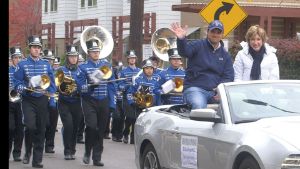 Fred DiSanto, (WRC '85, MGT '86), now chair of the university's Board of Trustees, and Barbara R. Snyder rode together in the 2014 Homecoming parade.
Fred DiSanto, (WRC '85, MGT '86), now chair of the university's Board of Trustees, and Barbara R. Snyder rode together in the 2014 Homecoming parade.
After evaluating current academic needs, leaders decided the most promising option was to put the structure on university property known as West Campus, site of the Mt. Sinai Medical Center before it closed. To ensure a strong start to the university's most ambitious project since Snyder arrived, she and her team decided to approach two organizations simultaneously: the Mt. Sinai Health Care Foundation, created from the former hospital's proceeds, and the Cleveland Foundation, the country's first community focused philanthropic organization. Both had made significant commitments in the past, but this time was different: The ask—$10 million each—would exceed any award in either philanthropy's history.
But by then, she had earned their trust.
"Barbara is a person of such high integrity that she quickly built lines of trust between herself and the other major institutional heads," said Cleveland Foundation President and CEO Ronn Richard. "She's all about partnering and reaching out." Added Mt. Sinai President Mitchell Balk: "She asked for $10 million, and she got $10 million."
***
By August of 2014, the Tinkham Veale University Center had opened, on time and under budget. As USG president four years earlier, alumnus Duwain Pinder (CWR '10) had been among its most persistent advocates, citing a center as essential to forging a stronger sense of campus community.
"That building was really important to me," he said. "The 'Tink' is now that place where people engage and collaborate."
As, increasingly, was think[box]. A small pilot space that opened while fundraising continued had attracted 100,000 visits and spun out 20 student startups within three years. Within two years of the opening of its first phase within the Richey Mixon Building, nearly two-thirds of undergraduate users were reporting the building had played a role in their decision to enroll.
 Suzanne M. Rivera
Suzanne M. Rivera
—Suzanne M. Rivera, PhD, former Vice President for Research and Technology, became President of Macalester College July 1, 2020
Snyder had made improving the academic quality and diversity of entering classes a central focus of her presidency. When she first arrived, the university was accepting three of every four undergraduate applicants, with more than half of those enrolled from Ohio and fewer than three dozen from outside the United States.
By 2017, Case Western Reserve University was accepting just one of every three applicants and the average SAT score of entering students had grown by more than 100 points. In addition, Snyder had nearly doubled the number of first-year underrepresented minority students, and more than quintupled the total of entering international students. Through the university's capital campaign, the university had completed or begun more than 90 endowed professorships and raised more than $210 million for scholarships and other student support (including $1 million Snyder donated herself).
That fall, the Carnegie Corporation of New York recognized Snyder's contributions by naming her one of seven recipients of its prestigious Academic LeadershipAward. The honor came with a $500,000 grant to be spent on an academic initiative on campus. In the spring, she directed the entire amount to Student Success, an effort designed to connect students to services and support in a more coordinated and timely way.
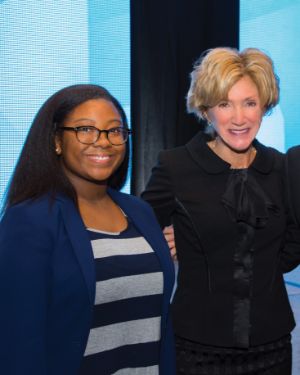 PHOTO: Daniel Milner Photography
PHOTO: Daniel Milner PhotographySierra Lipscomb (CWR '19), now a student at the School of Law, said Barbara R. Snyder "…made me feel like I could achieve anything."
Meanwhile, Snyder continued her own efforts to engage students whenever possible. Sierra Lipscomb (CWR 19), for example, first met Snyder after speaking at an event as a first-year undergraduate scholarship recipient.
From that moment forward, "every time she saw me, she remembered me, gave me a hug and she reminded me that I had a bright future ahead," recalled Lipscomb, now a second-year law student at Case Western Reserve University. "Receiving encouragement from the president of the university truly left a mark on me and made me feel like I could achieve anything."
***
In the spring of 2019, hundreds of people gathered in a 455,000-square-foot structure that stood across the street from Cleveland Clinic's main entrance.
They had come to dedicate the Health Education Campus, the joint university-hospital project that would house students from the university's nursing, dental medicine and medical schools, including the Cleveland Clinic Lerner College of Medicine program at Case Western Reserve University.
For people in the community when the ClinicColumbia headline hit nearly a dozen years earlier, the moment felt almost unimaginable. But then they had not seen how resolute Snyder had been in her high-road approach.
Even after Columbia's talks fizzled and Cosgrove still sought other suitors,she continued to invite him to events and capitalize on other chances to engage.
After Snyder announced that the new medical education building would stand somewhere other than the original structure's site, the Clinic's CEO asked for a meeting. Upon arriving, he suggested the pair partner on a joint building project—just a few blocks west of her proposed site.
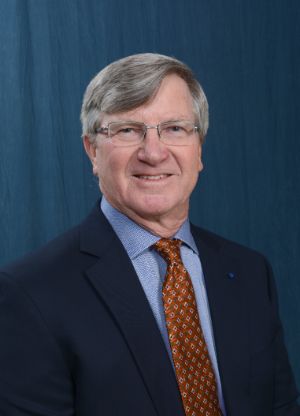 Hunter Peckham
Hunter Peckham
—Hunter Peckham, PhD (GRS '68, '72, biomedical engineering), Distinguished University Professor Emeritus and Donnell Institute Professor Emeritus
The rest, as they say, is history. As plans progressed, the pair embraced the idea of including nursing and dental students as well—what better way to prepare them for team-based care? As he listened to the speakers during the dedication, Mt. Sinai's Balk looked around the soaring atrium, expressly designed to encourage interaction among students, faculty and staff.
"A once-in-a-century advancement had been achieved for Cleveland's growth as a medical leader," he recalled thinking. "It was monumental for the future of Case Western Reserve University's leadership role in academic medicine and bioscience in this country."
And so, Snyder was standing on stage in the HEC's Sheila and Eric Samson Pavilion on Sept. 29, emphasizing one of the most common themes of her presidency: the power of partnership. Listening in the audience were her successor, Interim President Scott Cowen, DBA, and her final board chair, Fred DiSanto (WRC '85, MGT '86). During a farewell event the previous week, Cowen, (HON '11), had hailed Snyder's leadership, adding that he was "delighted to call her 'friend.'"
For his part, DiSanto spoke of the ways she had transformed the campus, and the people within it.
"These relationships that Barbara has built," he explained, "will last forever."
Continuing Barbara R. Snyder's Support for Student Scholarships
Case Western Reserve University created the Barbara R. Snyder Scholarship Fund to honor her extraordinary work as president and long-standing emphasis on access and affordability for students. It has raised $31 million. To donate, visit giving.cwru.edu/snyder.
Writer Ginger Christ contributed to this feature.


